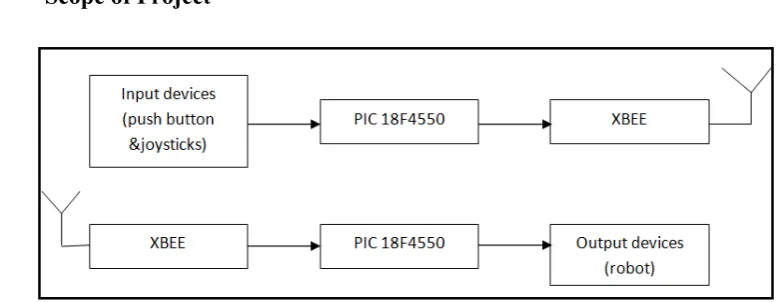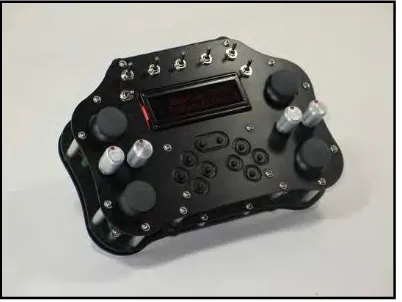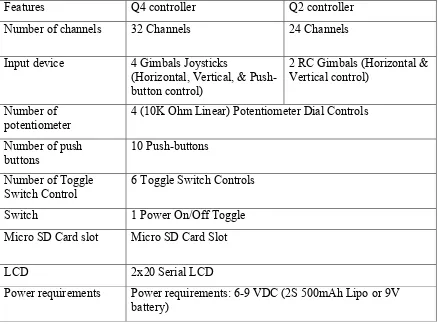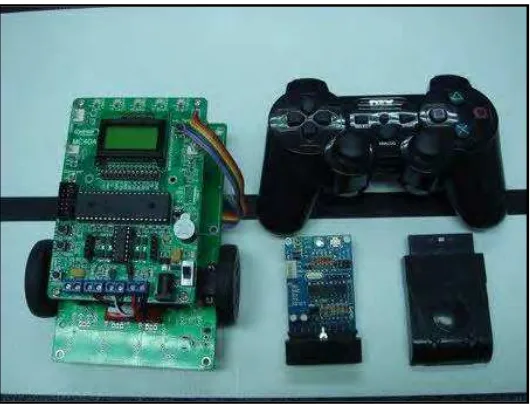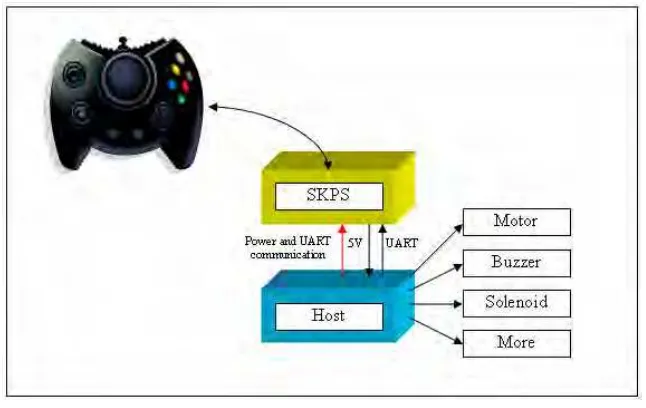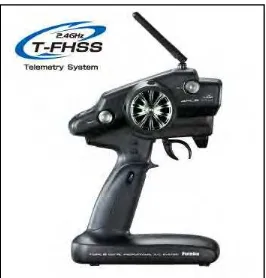i
PROJECT TITLE
WIRELESS REMOTE CONTROL UTILIZING XBEE FOR MOBILE ROBOT APPLICATION
JARIPAH BINTI ADZHAR
This Report Is Submitted In Partial Fulfillment of Requirements For The Bachelor Degree in Electronic Engineering (Computer Engineering)
Fakulti Kejuruteraan Elektronik dan Kejuruteraan Komputer Universiti Teknikal Malaysia Melaka
ii
DECLARATION
UNIVERSTI TEKNIKAL MALAYSIA MELAKA
FAKULTI KEJURUTERAAN ELEKTRONIK DAN KEJURUTERAAN KOMPUTER
BORANG PENGESAHAN STATUS LAPORAN PROJEK SARJANA MUDA II
Tajuk Projek : WIRELESS REMOTE CONTROL BY UTILIZING XBEE FOR MOBILE ROBOT APPLICATION
Sesi
Pengajian : 1 3 / 1 4
Saya JARIPAH BINTI ADZHAR mengaku membenarkan Laporan Projek Sarjana Muda ini disimpan di Perpustakaan dengan syarat-syarat kegunaan seperti berikut:
1. Laporan adalah hakmilik Universiti Teknikal Malaysia Melaka.
2. Perpustakaan dibenarkan membuat salinan untuk tujuan pengajian sahaja.
3. Perpustakaan dibenarkan membuat salinan laporan ini sebagai bahan pertukaran antara institusi pengajian tinggi.
4. Sila tandakan ( √ ) :
SULIT* *(Mengandungi maklumat yang berdarjah keselamatan atau kepentingan Malaysia seperti yang termaktub di dalam AKTA RAHSIA RASMI 1972)
TERHAD** **(Mengandungi maklumat terhad yang telah ditentukan oleh organisasi/badan di mana penyelidikan dijalankan)
TIDAK TERHAD
Disahkan oleh:
__________________________ ___________________________________
(TANDATANGAN PENULIS) (COP DAN TANDATANGAN PENYELIA)
iii
“Saya akui laporan ini adalah hasil kerja saya sendiri kecuali ringkasan dan petikan yang tiap-tiap satunya telah saya jelaskan sumbernya.”
Tandatangan : ………..
Nama Penulis : JARIPAH BINTI ADZHAR
iv
“Saya/kami akui bahawa saya telah membaca karya ini pada pandangan saya/kami karya ini adalah memadai dari skop dan kualiti untuk tujuan penganugerahan Ijazah Sarjana Muda Kejuruteraan Elektronik (Elektronik
Komputer).”
Tandatangan : ………...
Nama Penyelia : PUAN NUR FATIHAH BINTI AZMI
v
DEDICATION
To my beloved parents and siblings Adzhar abdul
Anang Abdulmoin Mardianah
Fatma Shylyna Siti khadija
vi
ACKNOWLEDGEMENT
vii
ABSTRACT
A wireless remote control is needed to control a robot from a certain range. This project intend to design a wireless remote control to control mobile robot by using XBee as the transmission medium and to design the communication protocol between the microcontroller of the transmitter and receiver. The existing wireless remote control was having problem with the reliability and the communication protocol between the microcontroller of the transmitter and receiver. Therefore to overcome the problem, a reliable wireless transmission medium has to be used and the new communication protocol to suit the functions of the mobile robot has to be developed. The designing process includes the designing of the circuit using the Proteus Software. The configuration of the XBee was done by using the XCTU software provided by the DiGi. MPLAB was used to create the communication protocol as required. Finally, a complete wireless remote control has been successfully developed with the new communication protocol. All the objectives
viii
ABSTRAK
ix
TABLE OF CONTENTS
CHAPTER TITLE PAGE
PROJECT TITLE ... I DECLARATION ... II DEDICATION ... V ACKNOWLEDGEMENT ... VI ABSTRACT ... VII ABSTRAK ... VIII TABLE OF CONTENTS IX LIST OF TABLES ... XI LIST OF FIGURES ... XII
I INTRODUCTION ... 1
1.1 INTRODUCTION OF PROJECT ... 1
1.2 OBJECTIVES OF PROJECT ... 3
1.3 PROBLEM STATEMENTS ... 3
1.4 SCOPE OF PROJECT ... 3
1.4.1 Software design 4 1.4.2 Target User 4 1.5 PROJECT SIGNIFICANCE ... 4
1.6 REPORT STRUCTURE ... 5
x
2.1 Q2 AND Q4 CONTROLLER ... 6
2.2 SKPS (PS2 CONTROLLER STARTER KIT) ... 9
2.3 4-PLS CONTROLLER ... 11
III METHODOLOGY ... 14
3.1 PROJECT IMPLEMENTATION ... 14
3.1.1 Input Devices 16 3.1.2 Microcontroller 17 3.1.3 Transceiver 18 3.2 DESIGN OF CIRCUIT ... 20
3.3 SOFTWARE DESCRIPTION ... 23
3.3.1 Configuration of XBee by using XCTU software 23 3.3.2 Communication Protocol 28 3.4 DESIGNING AND PRINTING THE CONTROLLER CASING .. 33
IV RESULTS AND DISCUSSION ... 36
4.1 RESULTS ... 36
4.1.1 Hardware Part of the Controller 36 4.2 DISCUSSIONS ... 44
V CONCLUSION AND RECOMMENDATION ... 47
5.1 CONCLUSION ... 47
5.2 RECOMMENDATION ... 49
xi
LIST OF TABLES
NO TITLES PAGE
2.1 Q2 and Q4 differences 8
3.1 Parameter configuration 30
xii
LIST OF FIGURES
NO TITLE PAGE
1.1 Block diagram for the whole system 3
2.1 Q4 controller 7
2.2 Xbee Pro 8
2.3 PS2 controller with SKPS and receiver 9
2.4 SKPS System Overview 10
2.5 4PLS controller 11
2.6 Several Telemetry functions can be displayed on the screen at once 12
3.1 Flowchart of project implementation 15
3.2 Block Diagram of Overall System 16
3.3 Analog joystick and push button 16
3.4 Analog joystick pin 17
3.5 PIC18F4550 pin diagram 18
3.6 XBee Pro S1 Module 19
3.7: Schematic circuit designed in ISIS 20
3.8 PCB layout- Top copper 21
3.9 PCB layout- bottom copper 22
3.10 XCTU shortcut on desktop 23
3.11 XCTU selected from the menu 24
3.12 XCTU launch tab 25
3.13 Dialog box for successful Test/Query Operation 26
3.14 Selecting the Function Set 27
3.15 Setting of PAN ID 28
3.16 ASCII Code table 29
xiii
3.18 Transmitter (remote control) flowchart operation 31
3.19 Receiver (Robot) flowchart operation 32
3.20 Casing Top View 33
3.21 Casing Front view 33
3.22 3D printer 34
3.23 The printing is in progress 34
3.24 Mounting push button into the push button casing 35 3.25 The printed casing mounted with push button and joystick 35
4.1 The final product of controller 37
4.2 The arrangement of the top push button 37
4.3 The arrangement of the front push button 38
4.4 Analog joystick direction 38
4.5 The forward direction of joystick and the output on the
XCTU software 39
4.6 The backward direction of joystick and the output on the
XCTU software 40
4.7 The right direction of joystick and the output on the XCTU software 41 4.8 The left direction of joystick and the output on the XCTU software 42
4.9 Output on the XCTU software 43
4.10 The output on the XCTU when the push button was pressed 43
4.11 Initialization in the MPLAB programming 45
1
CHAPTER I
INTRODUCTION
Chapter 1 covers the introduction part of this Final Year Project of Degree. It contains subchapters of objectives, problem statements, scopes of project and methodology.
1.1 Introduction of Project
With the development of science and technology, rapid development of robotic has been increasing from year to year. According to Robotic Institute of America (RIA), a robot is a re-programmable, multi-functional manipulator (or device) designed to move materials, parts, tools or specialized devices through variable programmed motion of a variety task whereas s mobile robot is an automatic machine that is capable of movement in any given environment. Mobile robots have the capability to move around in their environment and are not fixed to one physical location and it can be found in industry, military and also in university that do research on it.
2
Teleoperation requires a user interface to translate operator commands to the robot and provide feedback from the robot to the operator [2].
Controller is a device that is used to control devices from certain ranges. The remote control signals can be sent through wired or wirelessly. A There is no doubt that wired controller provide a more reliable connection and much faster compared to wireless controller but somehow it is not practical for some application especially for mobile robot application. The limitations are due to the distance constraints and the wired might get snagged or cut. Wireless controller has longer distance coverage depending on the device specifications that being used but there is a potential that the transmission speeds can suffer from outside interference. Wireless connection is also more expensive compared to wired connection.
3
1.2 Objectives of Project
The main objective of this study is to develop a wireless remote control utilizing Xbee for mobile robot application. This objective is supported by the following sub objectives:
1) To develop a wireless remote control system by using Xbee.
2) To design the communication protocol between the PIC (Transmitter) and the PIC (Receiver).
1.3 Problem Statements
A wireless remote controller nowadays is more preferable compared to wired controller. This is due to the fact that wired controllers are not practical for some application especially for mobile robot application. However, the wireless signal of the existing wireless connection has distance constraints and the signals are easy to be interfered making the signal is less reliable. The communication protocol also needs to be modified to meet the new designed function of the controller.
1.4 Scope of Project
Figure 1.1 Block diagram for the whole system
4
connection. Figure 1.1 shows how the setup of the controller is done. It is divided into two parts, transmitter and receiver.
PIC that will be used is PIC18F4550. MP Lab Programming will be used to create the communication protocol between the microcontroller of the receiver and transmitter. The input devices will be push button and joystick.
1.4.1 Software design
MP Lab Programming will be used to create the communication protocol between the microcontroller of the transmitter and receiver. The assignation of the parameter will be referring to the ASCII code table.
1.4.2 Target User
Target user is for a group that needs a wireless controller to control a mobile robot. It can practically be used for Robot Competition that requires a reliable wireless controller.
1.5 Project Significance
This wireless controller provides a reliable yet cheaper compared to the other wireless controller in the market. This controller allows user not to worry about the loss of signal and the distance range that can be supported by the controller. Notice that this controller can support up to 750 meters line of sight with 2.4 GHz frequency.
The network connection can be locked to prevent any unauthorized users controlling the robot. Besides that, the network is not limited to point-to-point communication, it can also be set up create a multiple network connections.
5
1.6 Report Structure
The report consists of five chapters. Chapter 1 discusses the introduction of the project which includes the objectives of the project, problem statements; scope of the project, project significance and report structure.
Chapter 2 discuss about the Literature review. This chapter included literature review on Q2 and Q4 controller by Quantum Robotic, SKPS by Cytron Technology and lastly is about 4PLS Controller by Futaba.
The next chapter, chapter 3 discusses about Project Methodology of the project. The methodology involved system analysis, system design, system development and system testing.
Then, chapter 4 discusses about Result and Discussion of the project. It is about result full decision after the completion of this project.
6
CHAPTER II
LITERATURE REVIEW
2
This chapter presents an overview on the related topic and the background related to this study. This chapter covers three controllers literature review.
2.1 Q2 and Q4 controller
A controller is not just use in playing games but it is become even more useful as controller today‟s are being used to control particular robot. A wired controller does exist but it is not practical in controlling a distance robot. Thus, a wireless with a reliable connection is needed.
7
Figure 2.1 Q4 controller
According to the Quantum Robotics crew, there is not much difference between these two controllers only that Q4 is using four analog joystick gambles whereas Q2 is using two RC gambles. Quantum Roboticas came out with Q2 and Q4 based on their needs to control many parts of the robot and the available controller in the market does not provide that type of controller.
Both of the controllers have 10 push buttons, 6 switch toggle controls and 4 (10K Ohm Linear) Potentiometer Dial Controls to meet up their requirements. The Q4 and Q2 are a line of controllers based on a Parallax Propeller as the main processor and a XBee for transmitting data. The Propeller is a multi-core microcontroller that excels at parallel processing. It contains eight processors, or cores, (called cogs) which can operate simultaneously.
8
Figure 2.2 Xbee Pro
The differences and similarities of Q4 and Q2 are summarize in Table 2.1.
Table 2.1 Q2 and Q4 differences
Features Q4 controller Q2 controller
Number of channels 32 Channels 24 Channels
Input device 4 Gimbals Joysticks
(Horizontal, Vertical, & Push-button control)
2 RC Gimbals (Horizontal & Vertical control)
Number of
potentiometer 4 (10K Ohm Linear) Potentiometer Dial Controls Number of push
buttons 10 Push-buttons
Number of Toggle
Switch Control 6 Toggle Switch Controls
Switch 1 Power On/Off Toggle
Micro SD Card slot Micro SD Card Slot
LCD 2x20 Serial LCD
9
It is undeniable that this controller has its own advantages compared to the other controllers available in the market. The best controller comes with the best price. This controller is more expensive than others along with its advanced functionality.
2.2 SKPS (PS2 Controller Starter Kit)
Play station 2 offers a good human manual input for control system and can be obtained from any play store easily. The issue is problem will be arose if the controller applied to control particular system. The major problem is a new protocol to connect with PS2 socket is needed as PS2 socket is very unique and difficult to obtain [7]. Therefore, Cytron Technologies has designed PS2 Controller Starter Kit called SKPS to overcome this problem. Figure 2.3 shows the PS2 controller with its receiver and SKPS to control a mobile robot.
Figure 2.3 PS2 controller with SKPS and receiver
10
Figure 2.4 SKPS System Overview
Generally, there are two methods of using SKPS. It has been designed for interface to embedded system with 5V TTL (microcontroller) or connection to computer (normally for functionality test) [6].
Since SKPS is PS2 Controller Starter Kit, the transmission medium is through Bluetooth connection. Bluetooth is an open standard that enables communication among diverse with their peripherals [3]. According to Michigan State University, Bluetooth's discovery protocol lets devices automatically find and start interacting with each other. This unintentionally exposes access and data to unauthorized users, leaving users at risk for potential hijacking incidents and identity theft. This theory is supported by the George Mason University, Bluetooth technology is omni-directional, meaning that their signals cover all directions. When other devices are present in the same space, signals from Bluetooth can get distorted in the direction of its intended recipient.
11
2.3 4-PLS Controller
Based upon the experience and know-how obtained from Aircraft transmitters, Futaba has designed a new telemetry transmitter 4PLS as shown on Figure 2.5. It has the newly developed telemetry system T-FHSS that is faster and more reliable. It allows the user to monitor receiver voltage and other important functions of a car in real time by optional sensors as can be seen in Figure 2.5. Telemetry is formally defined as the use of telecommunications for automatically indicating or recording measurements at a distance from the measuring instrument. Telemetry is the highly automated communications process by which measurements are made and other data collected at remote or inaccessible points and transmitted to receiving equipment for monitoring [3]. The word is derived from Greek roots: tele = remote, and metron = measure. Telemetry has been used by weather balloons for transmitting meteorological data since 1920.
